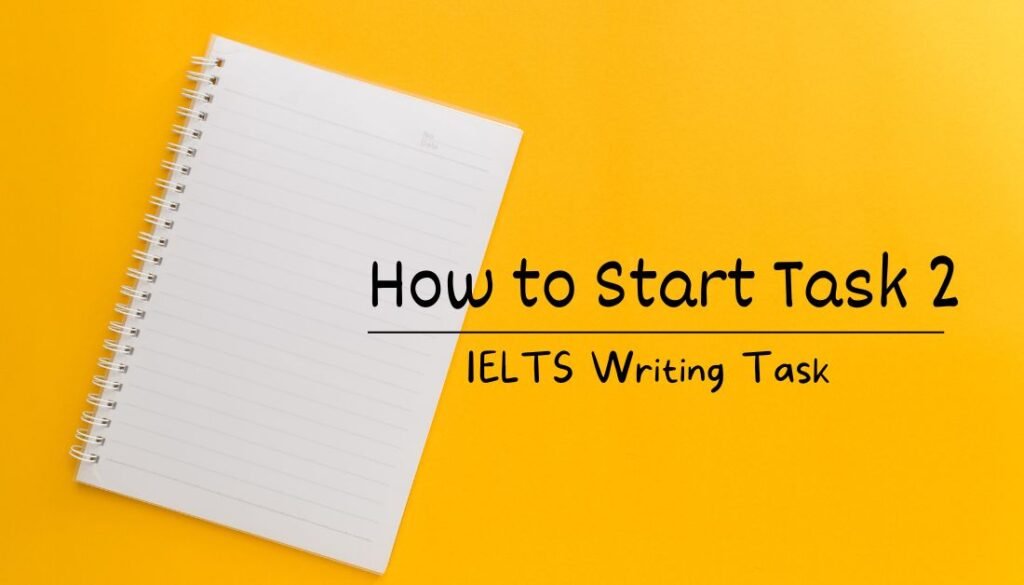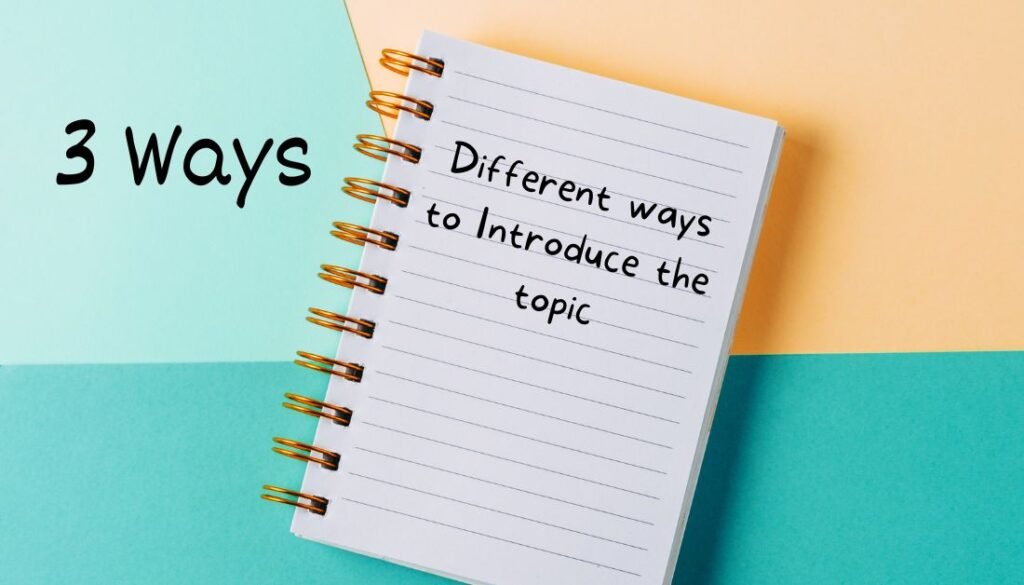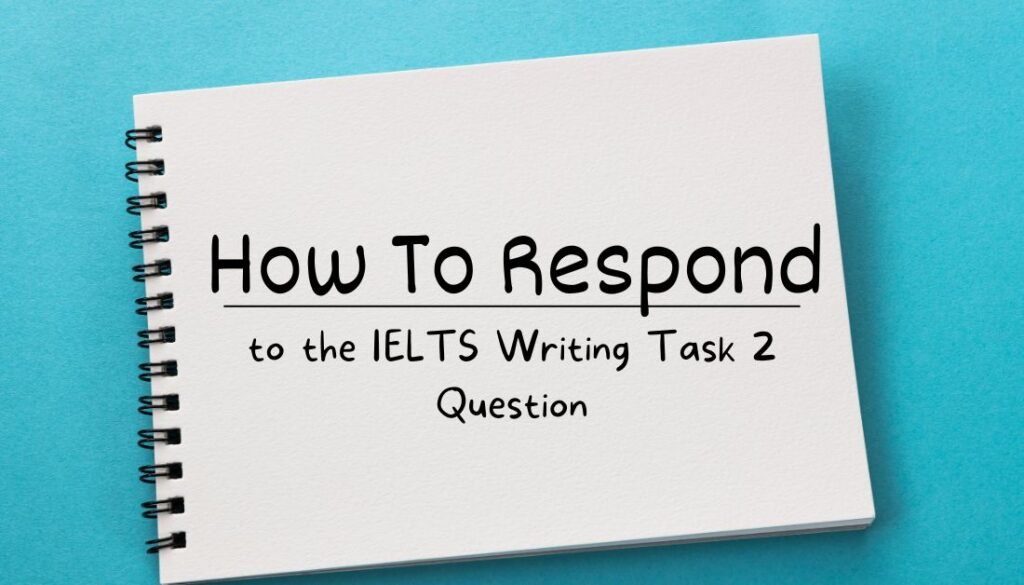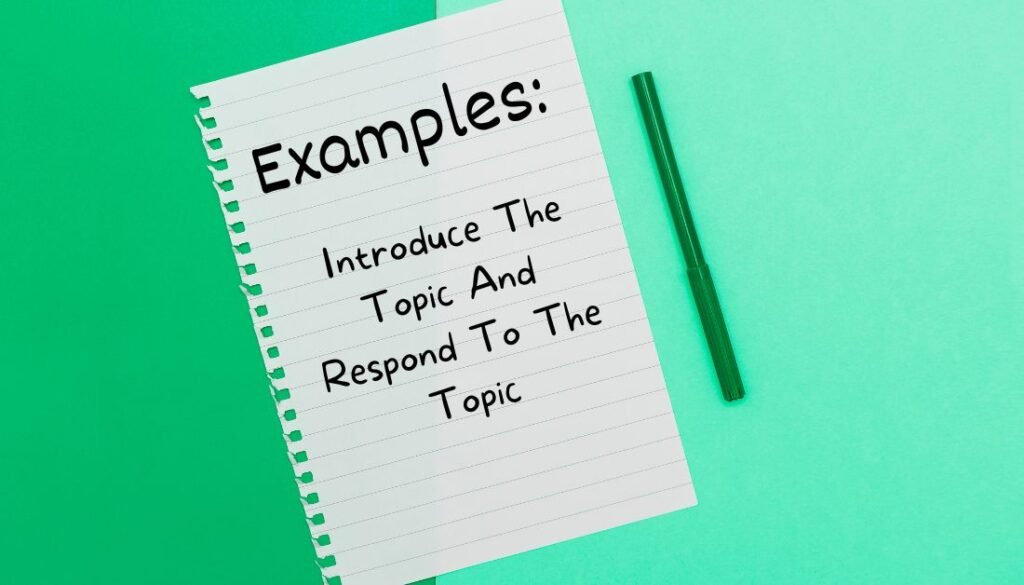How to Start Task 2 in IELTS: In this lesson, you will be learning how to write the introduction for our IELTS essays. Now, broadly speaking, our introduction should do two things. First of all, it should introduce the topic. For example, this will be between one and two sentences long. And then, after that, we’re going to respond to the question, and that’s also one to two sentences.
How to Start Task 2 in IELTS

Imagine you do the IELTS writing test and you get this question:
Teenagers should have regular exams at secondary school as this will prepare them better for life after leaving school. To what extent do you agree or disagree?
1. Underline the keywords
The first thing that you’re going to do is to underline the keywords that help you to understand the question. So, words like:
- teenagers
- regular exams,
- prepare them better for life after leaving school
2. Introduce the topic (1-2 sentences)
Now, when it comes to writing our introduction, the first thing we’re going to do is introduce the topic. For that, we’re going to use the rubric, so this section here. And what we’re going to do is paraphrase this in our own words. For example:
Introduction: Exams are an important feature of secondary education; however, there is contention over whether frequent exams prepare students for post-school life.
You’ll see that we’ve used different words than those words that appear in the rubric. For example:
Question: Teenagers should have regular exams at secondary school as this will prepare them better for life after leaving school. To what extent do you agree or disagree?
Answer: Exams are an important feature of secondary education, however, there is contention over whether frequent exams prepare students for post-school life.
Explanation:
- It says “teenagers should have regular exams” in the rubric, whereas in our introduction, we have “frequent exams.”
- In the rubric, it says “secondary school” and in our introduction, we have “secondary education” so a slight change.
- We have “life after leaving school” in our introduction, we have “post-school life.”
The idea is when we’re introducing the topic, we’re paraphrasing the statement, we’re paraphrasing the rubric, and we’re trying to use synonyms instead of using the same words that appear in the statement.
3. Respond to the Question (1-2 sentences)
Now, the next thing we’re going to do is respond to the question, and this is also going to be one to two sentences long.
To what extent do you agree or disagree?
Answer:
In this essay, I will argue that teenagers should be given regular exams at secondary school as this will help them to be prepared for their academic and professional life after they have left school. [How to Start Task 2 in IELTS]
Explanation:
- Make sure you understand the topic: When we’re responding to the question, we need to be very, very careful that we’re showing the examiner that we fully understand the question that’s been asked. Because of that, I advise you not to use synonyms unless you’re 100% sure.
- Be careful with synonyms: When we’re introducing the topic, yes, we paraphrase and use synonyms. When we’re responding to the question, we only use synonyms if we’re 100% sure. For example:

- In the rubric, in the statement, it will say “teenagers” and we write “teenagers.”
- In the rubric, it will say “secondary school” and we write “secondary school“
- In the rubric, it says “life after leaving school” and we just changed it slightly to “after they have left school.”
We do this because we want to show the examiner that we fully understand the question. So, yes, use synonyms and paraphrasing when we’re introducing the topic, but when we’re responding to the question, you need to be very sure that you’re showing the examiner that you understand the exact question that you’re being asked. As a result, don’t use synonyms unless you’re 100% sure.
3 Different ways to Introduce the topic

There are some different ways to introduce the topic and respond to the IELTS Writing task two question:
1. Contrasting times
One of the most useful ways to introduce the topic is to contrast times. Suppose we this IELTS writing task 2 prompt:
Research shows that business meetings and business training are increasingly taking place online.
Do the advantages of this development outweigh the disadvantages?
1st Example:
In the past, business meetings and training seminars were usually held in person on the company premises. Nowadays, they are frequently being held online.
We have a structure to this introduction:
- In the past (verb phrase)
- Nowadays (verb phrase)
You can use this as a template for a lot of IELTS introductions, particularly those questions that talk about something that was different in the past and is different now in the present.
2nd Example:
So, we call this a development, and you can usually tell because they’ll say “this development” in the question. Let’s take another example:
Question: In many countries, parents are deciding to have children later in their lives. Do you think the advantages of this development outweigh the disadvantages?
Did you spot again that we have “this development”? So, we can use our template introduction structure. So we will write like this:
Answer: In the past, it was common for couples to settle down and have children in their early 20s. Nowadays, many couples are waiting until their 30s to start a family.
3rd Example:
Let’s have a look at a third example.
Question: Nowadays, it is becoming increasingly common for people to do their work from home rather than going into their place of work. What are the reasons for this? Is this a positive or negative development?”
we’ve spotted the word “development.” Let’s use our introduction structure.
Answer: In the past, the majority of work was carried out in offices or on the company premises. Nowadays, more and more people are switching to working from home.”
In short, when we have a development in the question that we’re being asked, we can use this template structure. [How to Start Task 2 in IELTS]
Students Also Read: How to Generate Ideas for IELTS Writing: Brainstorm Essay
2. Contrasting Opnions
Another useful template is when we introduce contrasting opinions, and I’ll show you an example.
Some people believe that individuals should be allowed to own a gun as a means to protect themselves and their families.
To what extent do you agree or disagree with this statement?
1st example: That’s how we wrote the introduction:
Some people feel that the possession of firearms should be legalized on the grounds that they are necessary for personal protection and maintaining the safety of their families. Others argue that widespread possession of guns will lead to a more dangerous society.
Contrasting opinion structure:
We have a new structure: For example:
- some or many people feel, believe, think that
- others argue that
We can use this template structure when we have phrases like ‘some people,’ so the question clearly shows that there’s a difference in opinions.
2nd Example:
Some people believe that people should be required to retire from their career at a particular age. Others believe that people should be allowed to work as long as they like.
Discuss both these views and give your opinion.
Note: we have ‘some people,’ so the question is showing us that there’s a debate in opinions. Let’s use our template:
Answer: Some people think that there should be a mandatory retirement age. Others argue that there should be no limits to how long a person is allowed to work.
3. Grammar for introducing the topic
Now we also have certain grammatical structures that we use when we introduce to the question. let’s take our model question:
Teenagers should have regular exams at secondary school as this will prepare them better for life after leaving school.
To what extent do you agree or disagree?
Example 1: Present Simple Tense for General Statements
Note: when we talk about general statements and facts, we use the present simple tense.
Exams are an important feature of secondary school education. (So, this is a general statement, and we’re using the present simple)
Example 2: Present Perfect Tense for Recent or Unfinished Changes
If we want to talk about recent or unfinished changes, we’re going to use the present perfect.
Answer: Recently, many parents have begun to question whether their children are under too much stress.
Note: The word ‘recently’ identifies that we’re talking about a recent change. As a result, we’re going to use the present perfect.
Example 3: Present Perfect Continuous Tense for Recent or Unfinished Changes
We have another grammatical tense that we use regularly when we introduce the topic, and that is the present continuous. We use it when we want to talk about things which are changing right now.
Answer Example 1: The stress that young people are put under in high school is constantly rising.
Note: Here, we’re saying that it is constantly rising it means that it’s constantly changing, so we’re going to use the present continuous.
Answer Example 2: Parents are becoming increasingly worried that their children are under too much pressure.
How to respond to the IELTS writing task 2 question

When we say respond to the question it means we show the the examiner that we have clearly understood the question. This should be one to two sentences long. As a result, we only use synonyms if we are 100% sure. So use synonyms while introducing the topic.
Note: But when it comes to responding to the question, we only use synonyms when we are 100% sure. And that’s because the examiner is looking at this part of your introduction to see whether you have understood the question. [How to Start Task 2 in IELTS]
When we respond to the question, we introduce the ideas that appear in our body paragraphs. So this is sometimes called a thesis statement.
For example:
Teenagers should have regular exams at secondary school as this will prepare them better for the life after leaving school.
To what extent do you agree or disagree?
Answer: In this essay, I will argue that children should be given regular exams at secondary school as this prepares them for their academic and professional life after they have left school.
Explanation:
So the question says ‘teenagers,’ and we have written ‘children.’ Are they synonyms? The answer is no. A better word would be ‘teenagers,’ so just use the same word from the rubric. So don’t use words like ‘children’ if they’re not 100% synonyms. It’s better to use the word from the statement. We could maybe use ‘adolescence’ here because we know ‘adolescents’ and ‘teenagers’ are perfect synonyms.
How to write Outline statements/Thesis statements
Now, when we’re writing our introduction, and when we’re responding to the question, we need an outline statement or a thesis statement.
It’s sometimes called. In this essay, I will argue that teenagers should be given regular exams at secondary school as this will help them be prepared for their academic and professional life after they have left school.
So our thesis statement tells the examiner what they’re going to read about later on in the essay. So in this case, they’re going to read about our idea that they are prepared for their academic and for their professional life after leaving school.
Structure: I will (argue, explain, present, describe, etc)
Express your opinion:
When we’re writing our thesis statement and responding to the question, we often need to express our opinion. Now, we can use phrases like I believe that, I would argue, etc.
However, there are some tricky phrases. you can use them when you are partially agree to the statement.
Teenagers should have regular exams at secondary school as this will prepare them better for the life after leaving school.
To what extent do you agree or disagree?
For example:
- Take into account: In this essay, I will argue that regular exams do prepare teenagers for life after school, but we should also take into account how those exams are carried out. Okay.
- Provided: In this essay, I will argue that regular exams do prepare teenagers for life after school, provided that they are carried out in a sensible way.
- It depends on: In this essay, I will argue that regular exams do prepare teenagers for life after school, but realize that it depends on how those exams are carried out.
So we can use phrases like ‘take into account,’ ‘provided,’ and ‘it depends on’ to partially agree.
Examples: Introduce The Topic And Respond To The Topic

Now, what we’re going to do is look at some example introductions for all of the most common essay question types, and they are the agree-disagree, the advantage-disadvantage, discussion, double question, and direct questions. [How to Start Task 2 in IELTS]
Example 1: Agree/Disagree Questions
Some people believe that individuals should be allowed to own a gun as a means to protect themselves and their families.
To what extent do you agree or disagree with this statement?
Answer:
- Introduce the topic: Some people feel that the possession of firearms should be legalized on the grounds that they are necessary for personal protection and maintaining the safety of their families.
- Respond to the topic: I completely disagree. In this essay, I will argue that individuals should not be allowed to own a gun as it will be difficult to regulate who has access to these weapons and may lead to a more dangerous society.
Explanation:
Here, ‘I completely agree‘ clearly shows the examiner what your response is, what your position is, what your opinion is in relation to this question.
The phrase, ‘it will be difficult to regulate who has access to these weapons and may lead to a more dangerous society,’ shows the examiner why I completely disagree, and these are the arguments that I’m going to develop in my IELTS essay.
Students Also Read: Writing Task 2 Introduction Starting Lines
Example 2: advantage/disadvantage question
In many countries, parents are deciding to have children later in their lives.
Do you think the advantages of this development outweigh the disadvantages?
You see “this development” word collection so we know we can use our “in the past, nowadays” time template.
Answer:
- Introduce the topic: In the past, it was common for couples to settle down and have children in their early 20s. Nowadays, many couples are waiting until their 30s to start a family.
- Respond to the question: In this essay, I will argue that having children later in life is beneficial for both the parents and the children.
Example 3: Discussion Questions
Some people believe that people should be required to retire from their career at a particular age. Others believe that people should be allowed to work as long as they like.
Discuss both these views and give your own opinion.
In this question we’ve got the “some people,” so let’s use our contrasting opinions template.
Answer:
- Introduce the topic: Some people think that there should be a mandatory retirement age. Others argue that there should be no limits to how long a person is allowed to work.
- Respond to the topic: In this essay, I will argue that people should be allowed to work as long as they like so that they can continue to earn money for the future.
Example 4: Double Questions
Traffic congestion is a growing problem in many of the world’s major cities.
Explain some possible reasons for this problem and suggest some solutions.
So, this is a very common double question type. We’ve got the reasons and then solutions. So we often have problems and solutions, causes and solutions or reasons and solutions.
Answer:
- Introduce the topic: Over the last decade, many people have shifted to choosing electric vehicles rather than petrol or diesel vehicles. However, others are discouraged from changing to electric cars because of their high price and the familiarity that they have with petrol vehicles.
- Respond to the topic: In this essay, I will argue that these obstacles can be overcome with an appropriate pricing model and information over the correct use of electric vehicles.
There are other types of double questions. Here’s another type:
Nowadays, it is becoming increasingly common for people to do their work from home rather than going into their place of work.
What are the reasons for this? Is this a positive or negative development?
This is quite a tricky question to get in IELTS. The first part asks what are the reasons. The second part asks or is more similar to an advantage-disadvantage essay. They’re saying, ‘Is this a positive or a negative development?’
Answer:
- Introduce the topic: In the past, the majority of work was carried out in offices or on the company premises. Nowadays, more and more people are switching to working from home. The development has been compounded by two factors: the advance in technology that has made it possible and the COVID pandemic, which has made it essential.
- Respond to the question: In this essay, I will explain that this is a positive development because it allows people to save time commuting and has also been beneficial for the environment.
Note: a more difficult question requires a slightly longer introduction. So, it’s ok to write a long introduction for these types of questions.
Example 5: Direct Questions
Finally, we have the last question type, which is not so common in IELTS. It tends to be slightly easier to write the introduction. It’s a direct question.
Research into new types of medicine is essential to improve health and deal with disease.
Who do you think should fund this research: private companies, individuals, or governments?
Answer:
Introduce the topic: Researching new types of medicine is integral to humankind. However, it can also be extremely expensive.
Respond to the question: In this essay, I will argue that governments should fund this research due to the costly nature of research and in order to ensure that any new medicine can be cheaply supplied to those most in need.
Conclusion
Remember when we write our introductions, we need to introduce the topic and respond to the question. [How to Start Task 2 in IELTS]
Okay, best of luck with your studies and your preparation for the IELTS writing test, and I’ll see you in the next lesson. Happy studying, bye then.
Students Also Read:
How to Practice for IELTS Exam: 7 Days, 1 Month, 3 Months
Which App Is Best For IELTS Preparation